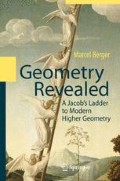Abstract
A lattice in \(\mathbb{R}^3\) is a Λ that can be written as the set of integer combinations of three linearly independent vectors \(\{a,b,c\}\), say \(\Lambda= \mathbb{Z} \cdot a+\mathbb{Z} \cdot b+\mathbb{Z} \cdot c\). As in Sect. IX.4, two Euclidean invariants are immediately associated with a lattice; they are practically dictated when we seek to pack balls of like radius in the densest possible way, thus the most economical for practical life; see more in Sect. X.4.
Access this chapter
Tax calculation will be finalised at checkout
Purchases are for personal use only
Preview
Unable to display preview. Download preview PDF.
Bibliography
[B] Berger, M. (1987, 2009) Geometry I, II. Berlin/Heidelberg/New York: Springer
[BG] Berger, M., & Gostiaux, B. (1987) Differential Geometry: Manifolds, Curves and Surfaces. Berlin/Heidelberg/New York: Springer
Aigner, M., & Ziegler, G.(1998). Proofs from THE BOOK. Springer
Ball, K. (1992). A lower boundfor the optimal density of lattice packings. International Mathematics Research Notices, 10, 217–221
Berger, M. (1999). Riemannian geometry during the second half of the twentieth century. Providence: American Mathematical Society
Berger, M. (2001a). Peut-ondéfinir la géométrie aujourd’hui? In B. Engquist, W.Schmid (Eds.), Mathematics unlimited- 2001 and beyond.Berlin/Heidelberg/New York: Springer
Berger, M. (2003). Apanoramic introduction to Riemannian geometry. Berlin/Heidelberg/New York: Springer
Betke, U., Henk, M., & Wills,J. (1994). Finite and infinite packings. Journal f¸r dieReine und Angewandte Mathematik, 453, 165–191
Boerdijk, A. (1952). Someremarks concerning close-packing of equal spheres. Philips Research Reports, 7, 303–313
Christophe Lesapeur Camembert. Albin Michel
Conway, J. (1995). Spherepackings, lattices, codes and greed. In Proceedings of theInternational Congress of Mathematicians (Zürich, 1994), Vol. 1. Birkhäuser, 45–55
Conway, J. H., & Sloane, N.J. A. (1999). Sphere packings, Lattices and Groups (3rd ed.). Berlin/Heidelberg/New York: Springer
Conway, J. H., & Sloane, N.J. A. (1993). Sphere packings, lattices and groups (2nd ed.). Berlin/Heidelberg/New York: Springer
De la Harpe, P., & Venkov, B. (2001). Groupes engendrés par des réflexions, designssphériques et réseau de Leech. Comptes Rendus, AcadÈmie des sciences de Paris, 333, 745–750
Dhombres, J., & Robert,J.-B. (1998). Fourier, créateur de la physique mathématique. Paris: Belin
Elkies, N. (2000). Lattices,linear codes, and invariants, Part I. Notices of the American Mathematical Society, 47(10), 1238–1945
Erdös, P., Gruber, P., & Hammer, J. (1989). Lattice points. New York: Longman Scientific and Technical, John Wiley
Fejes Tóth, L. (1972). Lagerungen in der Ebene, auf der Kugel und im Raum (2nd ed.). Berlin/Heidelberg/New York: Springer
Fournier, J.-C. (1977).Le théorème du coloriage des cartes (ex-conjecturedes quatre couleurs), Séminaire Bourbaki, 1977–78 Lecture Notes in Mathematics, 710, Springer, 41–64
Gruber, P., & Lekerkerker, C. (1987). Geometry of numbers. Amsterdam: North-Holland
Gruber, P., & Wills, J.(Eds.). (1993). Handbook of convex geometry. Amsterdam: North-Holland
Hales, T. (1994). The status ofthe Kepler conjecture. The Mathematical Intelligencer, 16, 47–58
Hales, T. (1997). Spherepackings. Discrete & Computational Geometry, 17, 1–51
Hales, T. (1999). Anoverview of the Kepler conjecture, http://arxiv.org/abs/math/9811071
Hales, T. (2000). Cannonballs and honeycombs. Notices of the American Mathematical Society, 47(4), 440–449
Hsiang, W.-Y. (1993). On thesphere packing problem and the proof of Kepler’s conjecture. International Journal of Mathematics, 4, 739–831
Kabatianski,G., & Levenshtein, V. (1978). Bounds for packings on a sphere andin a space. Problems of Information Transmission, 14, 1–17
Kac, M. (1996). Can one hear theshape of a drum? The American Mathematical Monthly, 73(4), part II, 1–23
Lee, R., & Szczarba, R. (1978). On the torsion in K4(Z) and K5(Z). Duke MathematicalJournal, 45, 101–129
Martinet, J. (1996). Les réseaux parfaits des espaces euclidiens. Paris: Masson
Mattila, P. (1995). Geometry of sets and measures in euclidean spaces.Cambridge: Cambridge University Press
Milnor, J. (1964). Eigenvalues of the Laplace operator on certain manifolds.Proceedings of the National Academy of Sciences of the USA, 51, 542
Milnor, J. (1994). Hilbert’sproblem 18: on crystallographic groups, fundamental domains, and onsphere packing. In J. Milnor Collected papers, Publish or Perish,Houston, 173–187
Morgan, F. (2005). Kepler’sconjecture and Hales proof – a book review, Notices of theAmerican Mathematical Society, 52(1), 44–47
Mumford, D. (2000). The dawning age of stochasticity. In Arnold, Atiyah, Lax, Mazur (Eds.), Mathematics: frontiers and perspectives (pp. 199–218). Providence: American Mathematical society
Oesterlé, J.(1990). Empilements de sphères, Séminaire Bourbaki1989–1990. In Astérisque 189–190, 375–398
Oesterlé, J.(1999). Densité maximale des empilements de sphères endimension 3 (d’après Thomas C. Hales et Samuel P. Ferguson),Séminaire Bourbaki 1989–1990. InAstérisque 266, 405–413
Pöppe, C. (1999). Laconjecture de Kepler démontrée. Pour la Science,259, mai 1999, 100–104
Reid, C. (1970). Hilbert. Beriln/Heidelberg/New York: Springer
Rigby, J. (1998). Precise colourings of regular triangular tilings. The Mathematical Intelligencer, 20, 4–11
Rogers, C. (1964). Packings and coverings. Cambridge: Cambridge UniversityPress
Rosenbloom, M., & Tsafsman, M. (1990). Multiplicative lattices in global fields. Inventiones Mathematicae, 101, 687–696
Schiemann, A. (1997). Ternary positive definite quadratic forms are determined by their theta series, Mathematische Annalen, 308, 507–517
Serre, J.-P. (1970). Cours d’arithmétique. Paris: Presses Universitaires de France
Sullivan, J. (1994). Sphere packings give an explicit bound for the Besikovitch coveringtheorem. Journal for Geometric Analysis, 4, 219–231
Thomas, R. (1998). An updateon the four-color theorem. Notices of the American Mathematical Society, 45(7), 848–859
Thompson, T. (1983).From error-correcting codes through sphere packings tosimple groups. Washington: Mathematical Association of America
Torquato, S. & Stillinger, F., (2006). New conjectural bounds on the optimaldensity of sphere packings. Experimental Mathematics, 15(3), 307–332
Wills, J. (1991). An ellipsoidpacking in E3 of unexpected high density. Mathematika, 38, 318–320
Wills, J. (1998). Spheres and sausages, crystals and catastrophes – and a joint packing theory, The Mathematical Intelligencer, 20(1), 16–21
Zong, C. (1996). Strange phenomena in convex and discrete geometry. Berlin/Heidelberg/New York: Springer
Zong, C. (1999). Sphere packings. Berlin/Heidelberg/New York: Springer
Author information
Authors and Affiliations
Corresponding author
Rights and permissions
Copyright information
© 2010 Springer-Verlag Berlin Heidelberg
About this chapter
Cite this chapter
Berger, M. (2010). Lattices and packings in higher dimensions. In: Geometry Revealed. Springer, Berlin, Heidelberg. https://doi.org/10.1007/978-3-540-70997-8_10
Download citation
DOI: https://doi.org/10.1007/978-3-540-70997-8_10
Published:
Publisher Name: Springer, Berlin, Heidelberg
Print ISBN: 978-3-540-70996-1
Online ISBN: 978-3-540-70997-8
eBook Packages: Mathematics and StatisticsMathematics and Statistics (R0)

